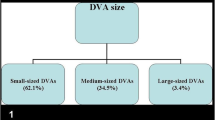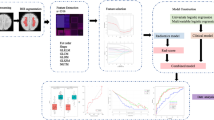Abstract
Objective
Susceptibility-weighted imaging (SWI) can be used to evaluate deep medullary veins (DMVs). This study aimed to apply texture analysis on SWI to evaluate developmental and ischemic changes of DMV in infants.
Methods
A total of 38 infants with normal brain MRI (preterm [n = 12], term-equivalent age [TEA] [n = 18], and term [n = 8]) and seven infants with ischemic injury (preterm [n = 2], TEA [n = 1], and term [n = 4]) were included. Regions of interests were manually drawn to include DMVs. First-order texture parameters including entropy, skewness, and kurtosis were derived from SWI. The parameters were compared between groups according to age and presence of ischemic injury. A regression analysis was performed to correlate postmenstrual age (PMA) and parameters. A ROC analysis was performed to differentiate ischemic infants from normal infants.
Results
Among parameters, entropy showed a significant difference between the age groups (preterm vs. TEA vs. term; 5.395 vs. 4.885 vs. 4.883, p = 0.001). There was a significant positive relationship between PMA and entropy (R square = 0.402, p < 0.001). Skewness was significantly higher in the ischemic group compared with that in the normal group (1.37 vs. 0.70, p = 0.001). The ROC on skewness resulted in an AUC of 0.87 (accuracy, 83.2%) for differentiating infants with ischemic injury.
Conclusion
A texture analysis of DMVs on SWI showed differences according to age and presence of ischemic injury. The texture parameters can potentially be used as quantitative markers for differentiating infants with ischemic injury through DMV changes.
Key Points
• The DMV structure of the infant brain could be quantified on SWI with texture analysis.
• Entropy from texture analysis on SWI increased as infants got older.
• Normal and ischemic injured infants could be differentiated with a cutoff value of 1.025 for skewness.





Similar content being viewed by others
Abbreviations
- AUC:
-
Area under the curve
- CI:
-
Confidence interval
- DMV:
-
Deep medullary vein
- DTI:
-
Diffusion tensor imaging
- DWI:
-
Diffusion-weighted imaging
- ICC:
-
Interclass correlation coefficient
- MRI:
-
Magnetic resonance imaging
- PMA:
-
Postmenstrual age
- ROC:
-
Receiver operating characteristic curve
- ROI:
-
Region of interest
- SWI:
-
Susceptibility-weighted imaging
- T1WI:
-
T1-weighted imaging
- T2WI:
-
T2-weighted imaging
- TEA:
-
Term-equivalent age
- WM:
-
White matter
References
Holland BA, Haas DK, Norman D, Brant-Zawadzki M, Newton TH (1986) MRI of normal brain maturation. AJNR Am J Neuroradiol 7:201–208
Volpe JJ (2009) Brain injury in premature infants: a complex amalgam of destructive and developmental disturbances. Lancet Neurol 8:110–124
Li AM, Chau V, Poskitt KJ et al (2009) White matter injury in term newborns with neonatal encephalopathy. Pediatr Res 65:85–89
Krageloh-Mann I, Horber V (2007) The role of magnetic resonance imaging in elucidating the pathogenesis of cerebral palsy: a systematic review. Dev Med Child Neurol 49:144–151
Haacke EM, Mittal S, Wu Z, Neelavalli J, Cheng YC (2009) Susceptibility-weighted imaging: technical aspects and clinical applications, part 1. AJNR Am J Neuroradiol 30:19–30
Sehgal V, Delproposto Z, Haacke EM et al (2005) Clinical applications of neuroimaging with susceptibility-weighted imaging. J Magn Reson Imaging 22:439–450
Arrigoni F, Parazzini C, Righini A et al (2011) Deep medullary vein involvement in neonates with brain damage: an MR imaging study. AJNR Am J Neuroradiol 32:2030–2036
Ramenghi LA, Govaert P, Fumagalli M, Bassi L, Mosca F (2009) Neonatal cerebral sinovenous thrombosis. Semin Fetal Neonatal Med 14:278–283
Kitamura G, Kido D, Wycliffe N, Jacobson JP, Oyoyo U, Ashwal S (2011) Hypoxic-ischemic injury: utility of susceptibility-weighted imaging. Pediatr Neurol 45:220–224
Tong KA, Ashwal S, Obenaus A, Nickerson JP, Kido D, Haacke EM (2008) Susceptibility-weighted MR imaging: a review of clinical applications in children. AJNR Am J Neuroradiol 29:9–17
Ryu YJ, Choi SH, Park SJ, Yun TJ, Kim JH, Sohn CH (2014) Glioma: application of whole-tumor texture analysis of diffusion-weighted imaging for the evaluation of tumor heterogeneity. PLoS One 9:e108335
Eliat PA, Olivie D, Saikali S, Carsin B, Saint-Jalmes H, de Certaines JD (2012) Can dynamic contrast-enhanced magnetic resonance imaging combined with texture analysis differentiate malignant glioneuronal tumors from other glioblastoma? Neurol Res Int 2012:195176
Zhang S, Chiang GC, Magge RS et al (2019) Texture analysis on conventional MRI images accurately predicts early malignant transformation of low-grade gliomas. Eur Radiol 29:2751–2759
Kuijf HJ, Bouvy WH, Zwanenburg JJ et al (2016) Quantification of deep medullary veins at 7 T brain MRI. Eur Radiol 26:3412–3418
Benninger KL, Maitre NL, Ruess L, Rusin JA (2019) MR imaging scoring system for white matter injury after deep medullary vein thrombosis and infarction in neonates. AJNR Am J Neuroradiol 40:347–352
Lee SM, Choi YH, You SK et al (2018) Age-related changes in tissue value properties in children: simultaneous quantification of relaxation times and proton density using synthetic magnetic resonance imaging. Invest Radiol 53:236–245
Huang BY, Castillo M (2008) Hypoxic-ischemic brain injury: imaging findings from birth to adulthood. Radiographics 28:417–439 quiz 617
Skogen K, Schulz A, Dormagen JB, Ganeshan B, Helseth E, Server A (2016) Diagnostic performance of texture analysis on MRI in grading cerebral gliomas. Eur J Radiol 85:824–829
Kim HG, Moon WJ, Han J, Choi JW (2017) Quantification of myelin in children using multiparametric quantitative MRI: a pilot study. Neuroradiology 59:1043–1051
Dean DC 3rd, O’Muircheartaigh J, Dirks H et al (2014) Modeling healthy male white matter and myelin development: 3 through 60months of age. Neuroimage 84:742–752
Huang YP, Okudera T, Fukusumi A et al (1997) Venous architecture of cerebral hemispheric white matter and comments on pathogenesis of medullary venous and other cerebral vascular malformations. Mt Sinai J Med 64:197–206
Okudera T, Huang YP, Fukusumi A, Nakamura Y, Hatazawa J, Uemura K (1999) Micro-angiographical studies of the medullary venous system of the cerebral hemisphere. Neuropathology 19:93–111
Hooshmand I, Rosenbaum AE, Stein RL (1974) Radiographic anatomy of normal cerebral deep medullary veins: criteria for distinguishing them from their abnormal counterparts. Neuroradiology 7:75–84
Friedman DP (1997) Abnormalities of the deep medullary white matter veins: MR imaging findings. AJR Am J Roentgenol 168:1103–1108
Kersbergen KJ, Benders MJ, Groenendaal F et al (2014) Different patterns of punctate white matter lesions in serially scanned preterm infants. PLoS One 9:e108904
Kocak B, Kizilkilic O, Zeynalova A, Korkmazer B, Kocer N, Islak C (2019) Evaluation of sporadic intracranial cavernous malformations for detecting associated developmental venous anomalies: added diagnostic value of C-arm contrast-enhanced cone-beam CT to routine contrast-enhanced MRI. Eur Radiol 29:783–791
Takanashi J, Suzuki H, Barkovich AJ et al (2003) Medullary streaks: dilated medullary vessels in chronic ischemia in children. Neurology 61:583–584
Meoded A, Poretti A, Benson JE, Tekes A, Huisman TA (2014) Evaluation of the ischemic penumbra focusing on the venous drainage: the role of susceptibility weighted imaging (SWI) in pediatric ischemic cerebral stroke. J Neuroradiol 41:108–116
Young A, Poretti A, Bosemani T, Goel R, Huisman T (2017) Sensitivity of susceptibility-weighted imaging in detecting developmental venous anomalies and associated cavernomas and microhemorrhages in children. Neuroradiology 59:797–802
Messina SA, Poretti A, Tekes A, Robertson C, Johnston MV, Huisman TA (2014) Early predictive value of susceptibility weighted imaging (SWI) in pediatric hypoxic-ischemic injury. J Neuroimaging 24:528–530
Iwasaki H, Fujita Y, Hara M (2015) Susceptibility-weighted imaging in acute-stage pediatric convulsive disorders. Pediatr Int 57:922–929
Polan RM, Poretti A, Huisman TA, Bosemani T (2015) Susceptibility-weighted imaging in pediatric arterial ischemic stroke: a valuable alternative for the noninvasive evaluation of altered cerebral hemodynamics. AJNR Am J Neuroradiol 36:783–788
Dai Y, Dong S, Zhu M, Wu D, Zhong Y (2014) Visualizing cerebral veins in fetal brain using susceptibility-weighted MRI. Clin Radiol 69:e392–e397
Nakamura Y, Okudera T, Hashimoto T (1994) Vascular architecture in white matter of neonates: its relationship to periventricular leukomalacia. J Neuropathol Exp Neurol 53:582–589
Takashima S, Tanaka K (1978) Development of cerebrovascular architecture and its relationship to periventricular leukomalacia. Arch Neurol 35:11–16
Miles KA, Ganeshan B, Hayball MP (2013) CT texture analysis using the filtration-histogram method: what do the measurements mean? Cancer Imaging 13:400–406
Koo TK, Li MY (2016) A guideline of selecting and reporting Intraclass correlation coefficients for reliability research. J Chiropr Med 15:155–163
Materka A, Strzelecki M (2015) On the effect of image brightness and contrast nonuniformity on statistical texture parameters. Found Comput Decis Sci 40:163–185
Fedorov A, Beichel R, Kalpathy-Cramer J et al (2012) 3D slicer as an image computing platform for the quantitative imaging network. Magn Reson Imaging 30:1323–1341
Zhang L, Fried DV, Fave XJ, Hunter LA, Yang J, Court LE (2015) IBEX: an open infrastructure software platform to facilitate collaborative work in radiomics. Med Phys 42:1341–1353
Orlhac F, Soussan M, Maisonobe JA, Garcia CA, Vanderlinden B, Buvat I (2014) Tumor texture analysis in 18F-FDG PET: relationships between texture parameters, histogram indices, standardized uptake values, metabolic volumes, and total lesion glycolysis. J Nucl Med 55:414–422
Frood R, Palkhi E, Barnfield M, Prestwich R, Vaidyanathan S, Scarsbrook A (2018) Can MR textural analysis improve the prediction of extracapsular nodal spread in patients with oral cavity cancer? Eur Radiol 28:5010–5018
Makanyanga J, Ganeshan B, Rodriguez-Justo M et al (2017) MRI texture analysis (MRTA) of T2-weighted images in Crohn's disease may provide information on histological and MRI disease activity in patients undergoing ileal resection. Eur Radiol 27:589–597
De Cecco CN, Ganeshan B, Ciolina M et al (2015) Texture analysis as imaging biomarker of tumoral response to neoadjuvant chemoradiotherapy in rectal cancer patients studied with 3-T magnetic resonance. Invest Radiol 50:239–245
Larue RT, Defraene G, De Ruysscher D, Lambin P, van Elmpt W (2017) Quantitative radiomics studies for tissue characterization: a review of technology and methodological procedures. Br J Radiol 90:20160665
Acknowledgments
The authors thank Hyesun Ko of the Ajou University Hospital for data-gathering.
Funding
This work was partly funded by the National Research Foundation of Korea (NRF-2017R1D1A1B03034768).
Author information
Authors and Affiliations
Corresponding author
Ethics declarations
Guarantor
The scientific guarantor of this publication is Hyun Gi Kim.
Conflict of interest
The authors of this manuscript declare no relationships with any companies, whose products or services may be related to the subject matter of the article.
Statistics and biometry
One of the authors has significant statistical expertise (Hye Sun Lee, Ph.D.).
Informed consent
Written informed consent was waived by the Institutional Review Board.
Ethical approval
Institutional Review Board approval was obtained.
Methodology
• Retrospective
• Cross-sectional study
• Performed at one institution
Additional information
Publisher’s note
Springer Nature remains neutral with regard to jurisdictional claims in published maps and institutional affiliations.
Electronic supplementary material
ESM 1
(DOCX 25 kb)
Rights and permissions
About this article
Cite this article
Kim, H.G., Choi, J.W., Han, M. et al. Texture analysis of deep medullary veins on susceptibility-weighted imaging in infants: evaluating developmental and ischemic changes. Eur Radiol 30, 2594–2603 (2020). https://doi.org/10.1007/s00330-019-06618-6
Received:
Revised:
Accepted:
Published:
Issue Date:
DOI: https://doi.org/10.1007/s00330-019-06618-6




